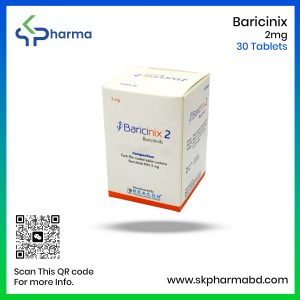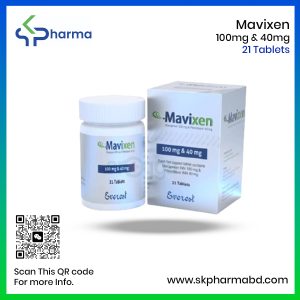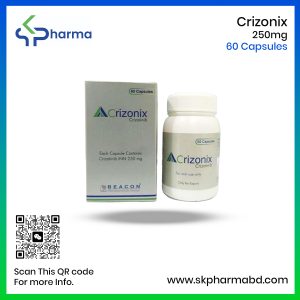Velpanex 400 Mg & 100 Mg (Sofosbuvir & Velpatasvir)
Related products
Product Description
Velpanex 400 mg & 100 mg (Sofosbuvir & Velpatasvir): A Breakthrough Combination for Hepatitis C Treatment
Introduction:
Velpanex 400 mg & 100 mg (Sofosbuvir & Velpatasvir) is a revolutionary fixed-dose combination tablet indicated for the treatment of adult patients with chronic hepatitis C virus (HCV) infection. This potent antiviral therapy is effective against multiple HCV genotypes and offers hope to millions of individuals suffering from this liver-damaging disease. In this comprehensive guide, we will explore the pharmacology, dosage, administration, interactions, side effects, and precautions of Velpanex, shedding light on its potential benefits and considerations during pregnancy and lactation.
Understanding Sofosbuvir and Velpatasvir:
Velpanex is an oral medication that combines two vital antiviral agents: Sofosbuvir and Velpatasvir. Each component targets specific proteins essential for the HCV replication process, making this combination highly effective in suppressing the virus and achieving sustained virological response (SVR).
1. Sofosbuvir: Sofosbuvir belongs to the class of nucleotide analog HCV NS5B polymerase inhibitors. By mimicking the viral RNA building blocks, Sofosbuvir disrupts the replication process, leading to a significant reduction in viral load.
2. Velpatasvir: Velpatasvir is an NS5A inhibitor that hinders the assembly and maturation of new HCV virions. Its mechanism of action complements Sofosbuvir, ensuring a higher barrier to resistance and broader efficacy against various HCV genotypes.
Dosage and Administration:
The recommended dosage of Velpanex is one tablet containing 400 mg of Sofosbuvir and 100 mg of Velpatasvir, to be taken orally once daily. The treatment duration may vary based on the patient’s cirrhosis status:
1. Patients without cirrhosis and patients with compensated cirrhosis (Child-Pugh A): The standard treatment duration is 12 weeks with one tablet daily.
2. Patients with decompensated cirrhosis (Child-Pugh B or C): The recommended treatment involves one tablet daily in combination with Ribavirin for 12 weeks. The Ribavirin dosage is based on the patient’s body weight and is divided into two daily doses.
Interaction and Contraindications:
Velpanex is a fixed-dose combination tablet designed to effectively treat chronic hepatitis C virus (HCV) infection. It offers a well-tolerated and convenient treatment option for patients with different HCV genotypes. Taken orally once daily, Velpanex comes in an easy-to-swallow tablet, enhancing patient compliance. With its potent antiviral agents, Sofosbuvir and Velpatasvir, Velpanex targets specific viral components crucial for HCV replication. The combination’s broad-spectrum efficacy and high barrier to resistance make it a breakthrough therapy. Its positive impact on patients without cirrhosis, as well as those with compensated or decompensated cirrhosis, reinforces its effectiveness across varying disease stages. For individuals seeking an efficient and user-friendly HCV treatment, Velpanex stands as a promising solution, paving the way toward better health outcomes.
Notably, coadministration of Velpanex with specific statins such as Rosuvastatin and Atorvastatin may elevate statin concentrations, necessitating close monitoring for potential side effects.
Velpanex, when used in combination with Ribavirin, is contraindicated during pregnancy. It is crucial for pregnant women and men whose female partners may become pregnant within the next six months to avoid this combination regimen.
Side Effects:
In general, Velpanex is well-tolerated, and its side effects are usually mild. The most common side effects reported are headaches and fatigue. Velpanex, however, is often prescribed in conjunction with amiodarone (a medication that is used for heart problems). A serious risk exists when Velpanex is taken with amiodarone, which causes serious symptoms of bradycardia (slowing of the heart rate). It is therefore recommended that Velpanex and amiodarone should not be given together, and in such cases, alternative treatment options should be explored. Patients should always consult with their doctor before taking Velpanex or any other drugs. It is important to inform the doctor of any other medications that are being taken, as some drugs can interact with Velpanex to cause severe side effects. Additionally, the doctor should be made aware of any pre-existing medical conditions.
Precautions and Warnings:
Those who are taking amiodarone or have underlying cardiac comorbidities or advanced liver disease, as well as those who are taking beta-blockers, should exercise cautiousness when taking Velpanex. Close cardiac monitoring is also recommended for these patients. Amiodarone and beta-blockers can both slow the heart rate, which can be dangerous when combined with Velpanex. People with underlying cardiac comorbidities and advanced liver disease may be more at risk for serious side effects, and therefore close cardiac monitoring is recommended.
Use in Special Populations:
For patients with severe renal impairment (eGFR ≤30 mL/min/1.73 m²) or end-stage renal disease (ESRD), no specific dosage recommendation can be provided due to higher exposures of the predominant sofosbuvir metabolite.
Overdose Effects:
In case of an overdose, careful monitoring for signs of toxicity is essential. The patient’s vital signs and clinical status should be closely observed.
Storage Conditions:
tablets should be stored in a cool and dry place, preferably below 30°C, and kept out of reach of children.
Conclusion:
Velpanex 400 mg & 100 mg (Sofosbuvir & Velpatasvir) is a groundbreaking combination therapy for the treatment of chronic hepatitis C virus infection. This fixed-dose tablet, containing Sofosbuvir and Velpatasvir, offers a highly effective, well-tolerated, and convenient treatment option for patients with various HCV genotypes. However, it is essential to consider potential drug interactions, side effects, and contraindications before initiating treatment. Pregnant individuals and their partners should exercise caution when using Velpanex in combination with Ribavirin. Regular monitoring and adherence to healthcare provider guidance are key to achieving successful treatment outcomes and improving the lives of individuals affected by HCV.






